This is a part of a series of posts analyzing the 2010 midterm elections. This post will focus on the Illinois Senate election, in which Republican candidate Mark Kirk pulled out a close Republican victory in a strongly Democratic state.
Illinois’s Senatorial Election
More below.
Senator Mark Kirk’s victory follows the contours of a previous post, titled Previewing Senate Elections: Illinois. This post argued:
So what does Mr. Kirk have to do? Say that he gets 35% of the vote in Cook County – propelled by inner-ring suburban strength and minority apathy – and wins a landslide everywhere else in the state (for instance, a 3:2 margin). This gives him 50.3% of the vote in the 2008 Illinois electorate. If white Republicans downstate turn out, and minorities in Chicago do not, Mr. Kirk may get bumped up to a 2-3% victory.
As it turns out, this is almost exactly what actually happened in the election.
The previous analysis divided Illinois into three sections: Chicago, the suburbs of Chicago, and downstate Illinois. Let’s take a look at what Mr. Kirk did in each part of Illinois.
Chicago
Illinois is generally a Democratic stronghold. Cook County, home to the city of Chicago, composes more than 40% of the state’s population, and Democrats always win by a landslide in the county. Republicans have to stretch themselves to the limit everywhere else in the state – winning even the areas that normally vote Democratic – to get close.
But Republicans also must dampen Democratic margins in Cook County. This happens if Republicans can do well in the parts of Cook County outside Chicago, which are whiter and more conservative. In the city of Chicago itself, most voters are so Democratic that they will prefer not voting to casting the ballot for a Republican. There, low turn-out is more important for Republicans than actually winning over voters.
In 2010, Democratic candidate Alexi Giannoulias won 64.3% of the vote in Cook County.
At first glance, this sounds quite good. Winning 64.3% of the vote is nothing to sniff at. No president has ever won that much of the popular vote in history.
But Senator John Kerry won 70.2% of the vote in Cook County. And President Barack Obama took 76.2% of the vote. In modern Illinois politics, a Democratic candidate who takes only 64.3% of the vote in Cook County is in deep trouble.
Chicago’s Suburbs
“Previewing Senate Elections, Illinois” stated that:
The true test of Mark Kirk’s candidacy will come in the Chicago suburbs…
He will not just have to win the suburbs, but turn the clock back two decades – back to the glory years in which Republicans won around 70% of the vote in DuPage County. (Mr. Kirk will probably not have to do that well, given rising Republican strength downstate.)
Is this doable? Given that Republicans seem to be winning suburbs everywhere this year, it is certainly possible. Mr. Kirk, moreover, has spent a decade representing a Chicago suburb congressional district; this is why Republicans have nominated him.
As it turned out, Mr. Kirk passed the test with flying colors. His moderate image and suburban origin led to double-digit victories in every one of the collar counties surrounding Cook County.
In the past, Republicans have won Illinois through massive support in the Chicago’s suburbs to offset the Democratic advantage in Chicago itself. Mr. Kirk was able to somewhat replicate this model in 2010:
This strength did not extend to all Republicans. Republican candidate Bill Brady, for instance, still won the Chicago suburbs. But his margins were just the slightest bit off – a high single-digit rather than double-digit victory here; a 15-point rather than 20-point margin there – and ultimately this led to Mr. Brady’s defeat.
Downstate Illinois
Imagine that the year is 1990, and Republican Mark Kirk pulls the exact same numbers in the Chicago metropolis.
Most analysts in that year would say that Mr. Kirk is on his way to a sure loss – after all, Democrats are quite competitive in downstate Illinois, and Mr. Kirk just hasn’t squeezed enough juice from the collar counties.
Today, however, downstate Illinois has trended firmly Republican. Without this trend Mr. Kirk would not have won.
Here is an illustration of Illinois in the 1992 presidential election:
President Bill Clinton is doing quite well, winning almost every single county downstate – many by double-digits. Compare this to President Barack Obama’s performance:
Mr. Obama is actually doing much better in Illinois than Mr. Clinton, and yet he loses a number of the downstate counties Mr. Clinton won.
This illustrates the shift in downstate Illinois to the Republican side, and in 2010 Mr. Kirk took full advantage of that trend to win re-election.
Conclusions
The post “Previewing Senate Elections: Illinois” concluded by mapping, somewhat light-heartedly, a hypothetical Republican victory:
Mr. Kirk’s victory ended up looking extremely similar:
All in all, it is always exciting to see a Republican victory in a Democratic stronghold, or a Democratic victory in a Republican stronghold. Mr. Kirk’s victory is the first time a Republican has won Illinois in quite a while. It constitutes one of the Republican Party’s greatest triumphs in the 2010 midterm elections.
–Inoljt
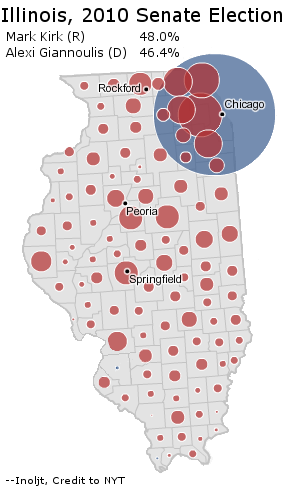

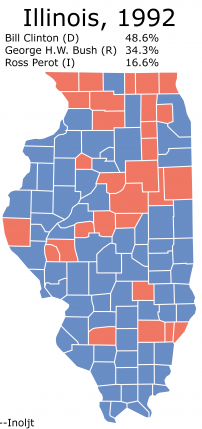
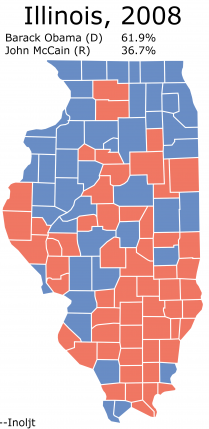
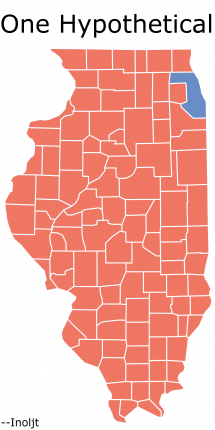
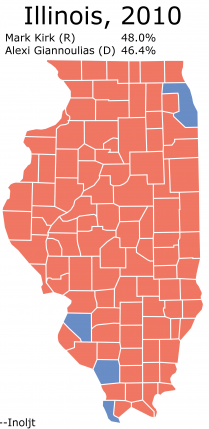
1 comment